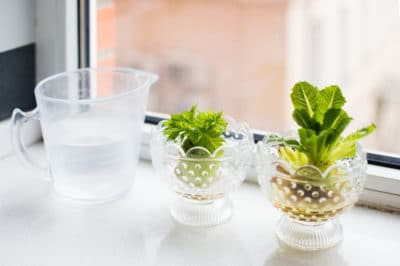How to Save Scraps
Fortunately, it’s often the part of the veggie that we don’t like to eat that is needed to regrow a plant. In the case of Romaine, this is the white stem base that holds all the leaves together. Typically when chopping a head of lettuce, this is what you have left over at the end. If you would like to save multiple stems, you can store them in a plastic bag with a spray of water.
Planting the Stem
Supplies:
- Shallow Dish
- Sunny Windowsill
- Optional: Toothpicks
Place your stem right side up into a dish of shallow water. The top of the stem is where the leaves grew out of, and the bottom is the reddish brown base of the stem where it was previously cut in the field.
The water should be enough to cover the bottom of the stem but allow the top to stick out. You can use three toothpicks pierced into the stem to hold it halfway into the jar or dish, but this isn’t necessary. It’s alright if the stem touches the bottom of the dish. A canning jar with a ring but no lid is handy. The stem has a natural cylinder shape to it, so it will sit perfectly in a canning jar with a ring attached.
Growing
Change out the water every three days to keep in clean and oxygenated. Soon you will see your Romaine scrap starting to sprout new leaves. It may also sprout new little roots from the bottom into the water. While regrown Romaine scraps will never again produce a nice head of lettuce, they will sprout enough greens for an additional meal.
After a week or two, the plant will get stressed and send out a flowering shoot. The leaves at this point will begin to get tough, bitter, and unpalatable. Potting the plant prior to it flowering can help it last longer if it’s grown enough of a root system.
Seeding
The harvest isn’t over once the plant starts to flower. Not only does watching it go through the natural cycle of flowering and seeding add to the educational value of this project, but it actually produces more lettuce.
The plant will flower, and the flowers will pollinate themselves. When the flowers wilt, the plant will produce seed.Save this seed for next year’s garden, and you’ve just turned a kitchen scrap into next years lettuce.
If saving seed from kitchen scraps, buy your lettuce at the farmers market to avoid getting hybrid varieties. Only open pollinated and heirloom varieties will produce true-to-type seedlings the following year.
